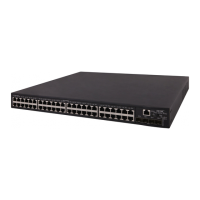23
3. VTEP 3 de-encapsulates the ARP request, creates an ARP entry for the user terminal, and
sends an ARP reply to the user terminal.
4. VTEP 1 forwards the ARP reply to the user terminal.
5. The user terminal learns the MAC address of the gateway, and sends the Layer 3 traffic to the
gateway.
6. VTEP 3 removes the VXLAN encapsulation and inner Ethernet header for the traffic, and
forwards the traffic to the destination node.
Inter-VXLAN forwarding is the same as this process except for the last step. At the last step of
inter-VLAN forwarding, the gateway replaces the source-VXLAN encapsulation with the
destination-VXLAN encapsulation, and then forwards the traffic.
Figure 10 Example of centralized VXLAN IP gateway deployment
Distributed VXLAN IP gateway deployment
As shown in Figure 11, each site's VTEP acts as a gateway to perform Layer 3 forwarding for the
VXLANs of the local site. A VTEP acts as a border gateway to the Layer 3 network for the VXLANs.
The VTEPs perform Layer 3 forwarding based on ARP or ND entries.
IMPORTANT:
The site-connected gateways are called distributed gateways. On the distributed gateways, you
must enable local proxy ARP (for IPv4 sites) or local ND proxy (for IPv6 sites).
VXLAN tunnel
VTEP 1 VTEP 2
Site 1 Site 2
Terminal
Terminal
Terminal
VSI/VXLAN 10
VSI/VXLAN 20
VSI/VXLAN 30
Terminal
Terminal
Terminal
VSI/VXLAN 10
VSI/VXLAN 20
VSI/VXLAN 30
Transport
network
P
10.1.1.11
20.1.1.11
30.1.1.11
10.1.1.12
20.1.1.12
30.1.1.12
VXL
AN
t
u
n
n
e
l
VXL
AN
t
u
n
n
e
l
VTEP 3/Centralized VXLAN IP gateway
VSI/VXLAN 10
VSI/VXLAN 20
VSI/VXLAN 30
VSI-interface10
10.1.1.1/24
VSI-interface20
20.1.1.1/24
VSI-interface30
30.1.1.1/24
L3 network

